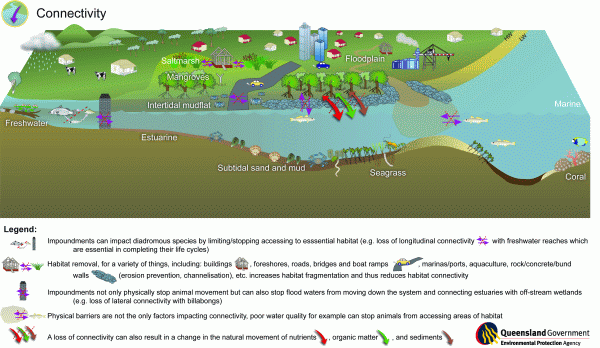Our current best conceptual understanding of the stressor ‘connectivity’ is shown in Figure 1.
Figure 1. Potential causes of a change to connectivity and the condition responses observed as a result of this change.
Connectivity is the ability of ecosystems to ‘connect’ to one another to form an interconnected network. The degree of this interconnectedness and its characteristics vary in wetland landscapes based mainly on topography and the degree of disturbance occurring there. The movement of water (with its associated parameters, e.g. nutrients, organic matter, pH, salinity) and organisms from place to place is the main aspect of connectivity considered here.
There are two aspects to connectivity, lateral connectivity is the ability of biota, water and materials to move between one distinct system such as an estuary to another such as a floodplain wetland. Longitudinal connectivity is the ‘upstream-downstream’, or within system connectivity that is important for the movement of species within the estuary (or between the estuary and its freshwater river system). As an example, impoundments can impact both lateral and longitudinal connectivity, firstly, by stopping flood water coming downstream and flooding floodplain areas, and secondly, by physically stopping fish movement up/downstream. The loss of riparian or shoreline connectivity through habitat removal can form a barrier to the movement of species. Physical obstructions/modification are not the only ways that connectivity is impacted, other factors such as water quality (e.g. salinity, pH) and velocity, or changes to climate patterns, can also create a barrier to biota movement.
Changes in the connectivity between freshwater waterbodies and the marine environment can have a major impact on diadromous fish life cycles.



